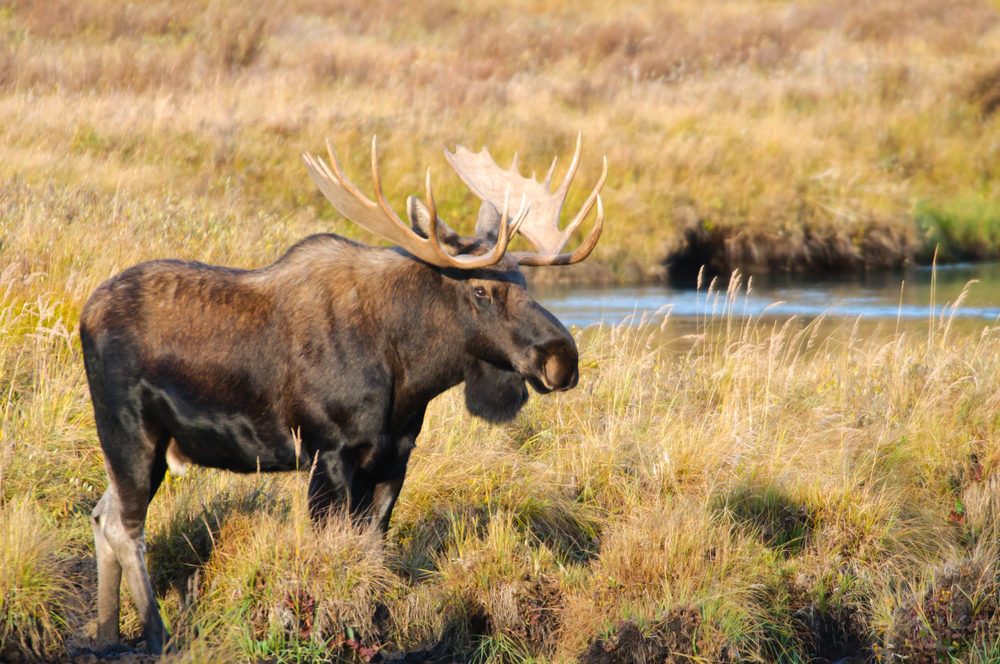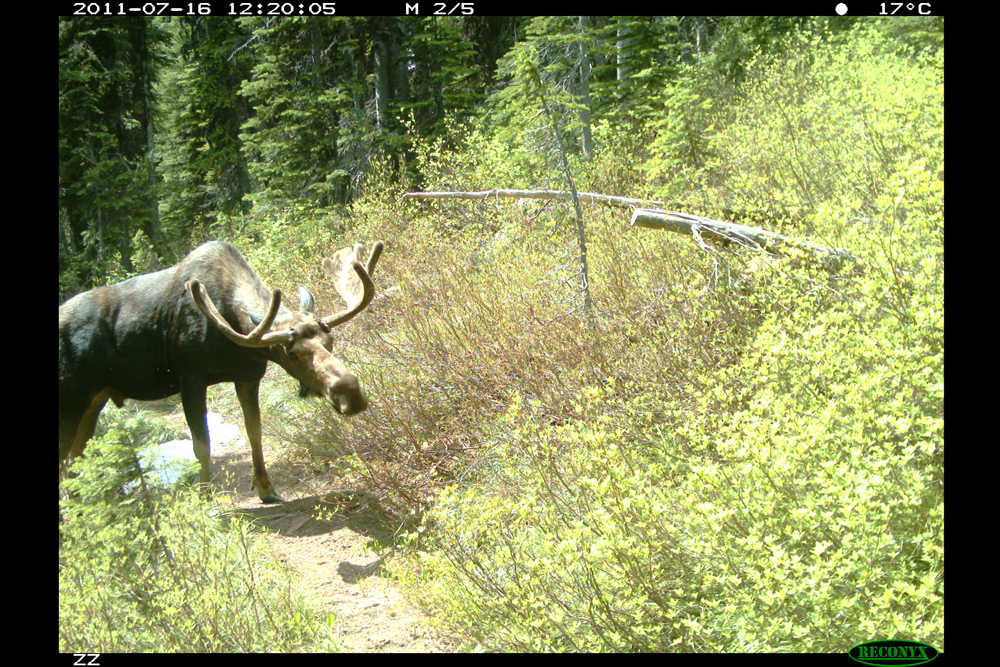Moose: Facts About the Largest Deer

Moose are large ungulates (hoofed mammals) identified by their long, rounded snouts; huge, flattened antlers; humped back; thin legs; and massive bodies. These animals live in the northern United States, Canada and Europe. In North America, they are called moose; in Europe, they are called Eurasian elk.
Size
Moose are the largest members of the deer family, according to the Alaska Department of Fish and Game. They are also the tallest mammals in North America. Their height, from hoof to shoulder, ranges from 5 to 6.5 feet (1.5 to 2 meters). Males are heavier than females; males weigh 794 to 1,323 pounds (360 to 600 kilograms), while females weigh 595 to 882 pounds (270 to 400 kg), according to the National Museum of Natural History.
Moose have short tails, a hump on their shoulders and large ears that can rotate to give them stereophonic hearing. Their fur is generally brown or black and provides excellent insulation from the cold. Male moose, called bulls, have massive antlers. These can grow 6 feet (1.8 m)wide from tip to tip. Antlers are only used for fighting for a mate, and they are shed each winter after mating season, which runs from September to October.
Habitat
Moose live only in areas that have seasonal snow cover. The animals prefer colder climates. They cannot tolerate temperatures above 80 degrees Fahrenheit (27 degrees Celsius) for long because they cannot sweat, and the fermentation caused by their digestion creates a large amount of heat, according to Animal Diversity Web (ADW), a database maintained by the University of Michigan's Museum of Zoology.
Habits
Moose are considered the least social animal, according to ADW. They are solitary animals, except when it comes to mating. During mating season, some dominant male moose in Alaska will herd a group of females together to create a "harem herd." Other males will fight the leader of the herd for the right to mate with the females.
The moose's most active times are at sunrise and at sunset. They spend their time finding new grazing spots, eating and resting to let their food digest, while always being wary of nearby predators, which include bears, wolves and cougars.
Diet
Moose is an Algonquin (a Native American tribe) term that means "twig eater," according to ADW. This is a good generalization of what moose eat in the wild. They tend to graze on the leaves, bark, pine cones, twigs and buds of trees and shrubs. They also like to eat aquatic plants like water lilies.
Moose have four-chambered stomachs, as do cows. They regurgitate partially digested food and "chew their cud," according to Kevin Jackson, author of "Moose" (Reaktion Books, 2008). Food is fermented in the first chamber, and nutrients are extracted in the next three.
Offspring
After a gestation period of 231 days, females give birth to one baby, which is called a calf. Within their first day of life, calves can stand up on their own. They weigh around 35.7 pounds (16.2 kg) at birth and grow very quickly,gaining 2.2 lbs. (1 kg) per day while they are nursing.
After 6 months, calves are weaned. At 4 to 6 years old they are fully grown, though many never make it to adulthood. Around 50 percent of calves die due to bear or wolf attacks before they are 6 weeks old, according to ADW. Once they are adults, they have a survival rate of up to 95 percent. Surviving moose typically live around 15 to 20 years.

Classification/taxonomy
Moose are part of the Cervidae family, which includes cervids, caribou, deer, moose and wapiti. The taxonomy of moose, according to the Integrated Taxonomic Information System (ITIS), is:
- Kingdom: Animalia
- Subkingdom: Bilateria
- Infrakingdom: Deuterostomia
- Phylum: Chordata
- Subphylum: Vertebrata
- Infraphylum: Gnathostomata
- Superclass: Tetrapoda
- Class: Mammalia
- Subclass: Theria
- Infraclass: Eutheria
- Order: Artiodactyla
- Family: Cervidae
- Subfamily: Capreolinae
- Genus & species: Alces alces, Alces americanus (American moose)
- Subspecies: Alces alces alces (European elk), Alces alces caucasicus (Caucasian moose — extinct), Alces americanus americanus, Alces americanus cameloides
While ITIS and some researchers list the American moose as a distinct species, there is still some debate about whether it is a true species (Alces americanus) or subspecies (Alces alces cameloides), according to the International Union for Conservation of Nature (IUCN). The group says, "Further research is needed before a consensus would support species-level classification."
Conservation status
The IUCN's Red List of Threatened Species categorizes moose as "least concern" because they are very widespread and extremely abundant despite fairly intense hunting. The global population of moose is estimated to be about 1.5 million and increasing. The Caucasian moose was hunted to extinction by the early 19th century.
Young moose are prey for bears, wolves and cougars; about half do not live beyond 6 weeks, according to ADW. Adult moose, however, have a high chance for survival. Vehicle-moose collisions pose the greatest danger to the animals, according to Alaska Fish and Game. Hundreds of moose are killed each year in Alaska, which has the highest rate of moose-vehicle collisions in the world.
The plural of moose
The plural of "moose" is "moose" — not "mooses" and not "meese." According to George W. Dunne, president of the Forest Preserve District of Cook County, Illinois, the plural is the same as the singular in many words that come from Native American languages. "That is true of most Indian names, whether of a tribe, such as the Winnebago and Potawatomi, or of an object, such as papoose," he wrote in a nature bulletin. "It is also true of many wildlife names not of Indian origin — for example: deer, mink and grouse."
Other facts
Moose hair is hollow. This type of fur helps to insulate the animal from the cold.
A moose's front legs are longer than its back legs. This helps the moose more easily jump over things lying in its path.
The hump on a moose's back is caused by massive shoulder muscles.
The flap of skin that hangs below a moose's chin is called a bell, according to National Geographic.
A moose's wide hooves act like built-in snowshoes, helping the moose walk in the snow.
Moose can run 35 mph (56 km/h) over short distances and trot at 20 mph (32 km/h) for longer periods.
Moose are strong swimmers and can swim up to 6 mph (9.5 km/h) and as far as 12.4 miles (20 km). Moose can also stay under water for 30 seconds when swimming.
Additional resources
Sign up for the Live Science daily newsletter now
Get the world’s most fascinating discoveries delivered straight to your inbox.











